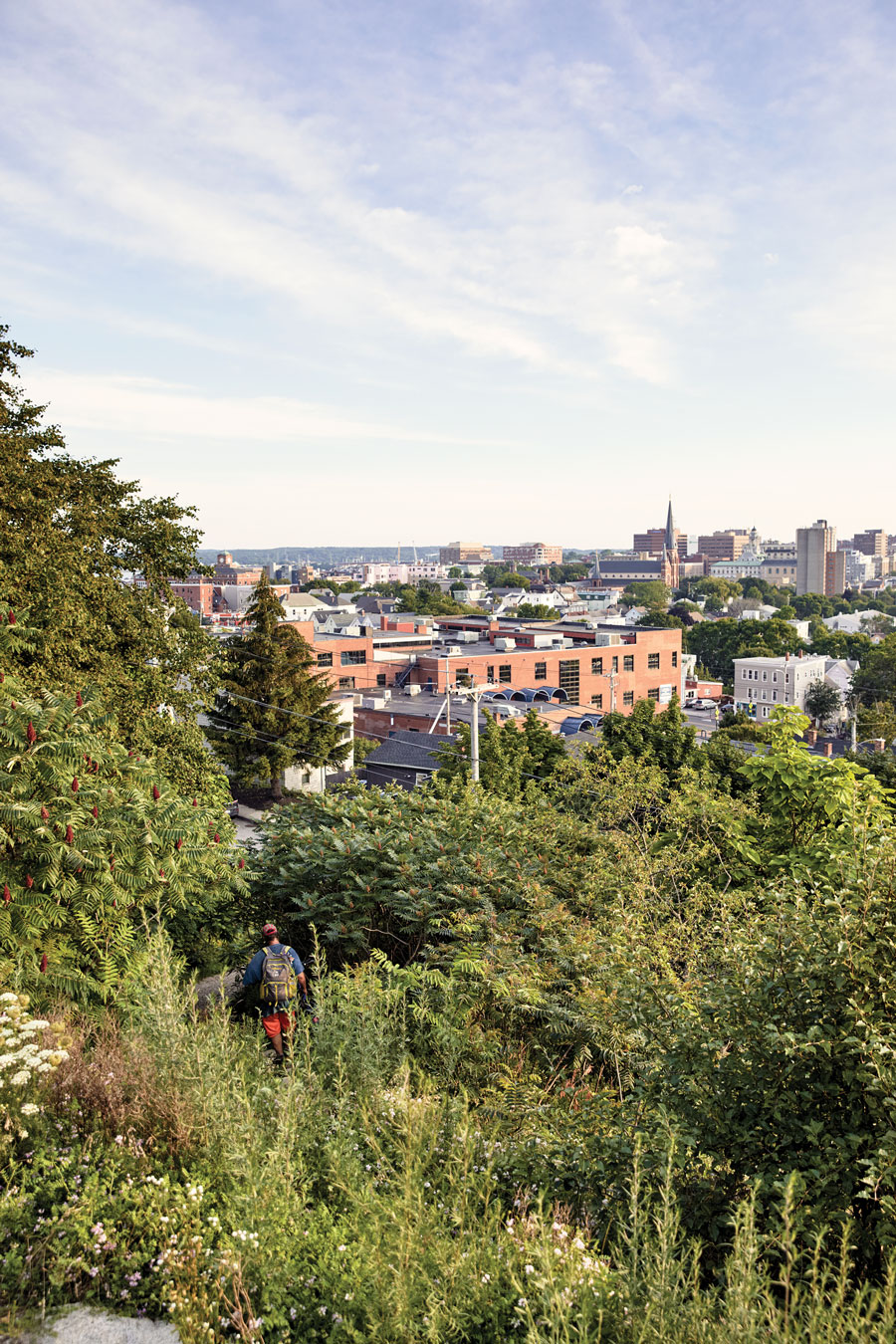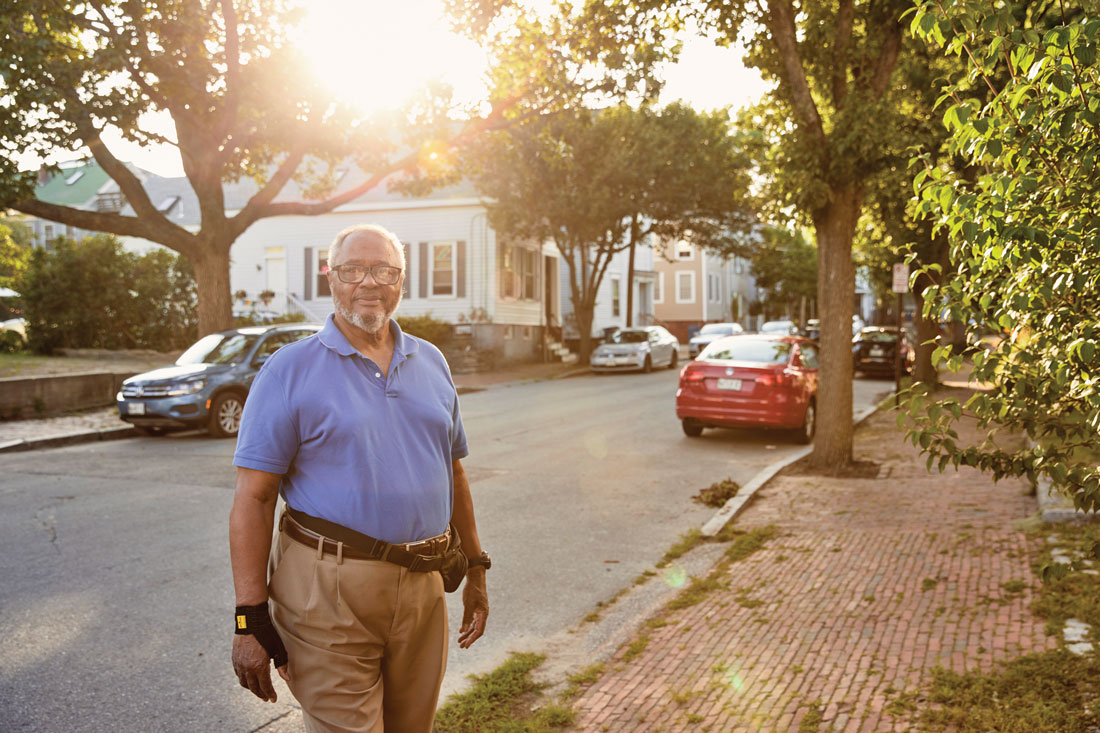Before Munjoy Hill Was Hip, It Was Their Home
Natives of Portland’s once-maligned Munjoy Hill neighborhood reflect on the place they knew, and the changing winds that have been steadily whooshing up the slope.

TEXT BY MICHAELA CAVALLARO
PHOTOGRAPHED BY MICHAEL D. WILSON
Hip. Upscale. Gentrified. As recently as 15 years ago, if you’d asked locals which Portland neighborhood these words describe, “Munjoy Hill” wouldn’t have tripped off their tongues. Since then, though, the city’s once-scrappy, easternmost neighborhood packed with modest vernacular, Greek Revival, Italianate, and Second Empire homes — as well as grand Queen Annes and Colonial Revivals on the promenade overlooking sailboat-dotted Casco Bay — has gotten a glow-up: cool boutiques, upscale restaurants, and the skyrocketing real estate prices that often signal out-of-state money.
While Portlanders love to complain about the changes, they’re also taking real steps to preserve the heritage of the neighborhood, which was once the city’s most diverse. Though progress was stalled by the coronavirus, the city council has been working toward creating a Munjoy Hill Historic District. Meanwhile, efforts to preserve the Abyssinian Meeting House, the nation’s third oldest built by a Black congregation, regained momentum following the Black Lives Matter protests last summer.
We asked three Munjoy Hill natives what it was like to grow up there — and how they feel about their new/old hood.

Bob Greene
Age: 84
Career: Retired after 36 years as a journalist for the Associated Press
Current home: South Portland
Childhood home: Lafayette Street, in a house his family bought in 1897
Unlike today, Munjoy Hill was a poor neighborhood. Nobody with money wanted to build on the Hill because you didn’t have insulation. So right where you catch the wind off the water, that’s where the poor people went. We had what I called a paper stove. It was a very thin tin stove. You’d put paper in and light it, and the stove would get almost white-hot. That’s when you would undress and put your pajamas on and get into bed. The minute the stove went out, it was cold again.
In school, I was four years behind any other Blacks, and four years ahead of [the next group of] Black students. So my playmates growing up were Italian and Jewish. My cousin William, who lived down on Anderson Street, was the first Black I went to school with — and that was in eighth grade at [the former] Jack Junior [High School on North Street]. Because [only two families on the street owned] cars, the street was our playground. When you were young and running those streets, you understood what all of the grandmothers were shouting at you when you did something wrong. It made no difference whether it was Italian or Polish or Yiddish.
If you go up [to Lafayette Street] today, it’s almost the same as it was when I was growing up. The big difference is that my house is gone and instead there’s a two-story house that replaced it. Next door was an empty lot that we used to play ball on, and I believe it’s very expensive condos now. We all have beautiful memories of our childhoods, but that’s the way life goes. Things change.

Rita Yarnold
Age: 71
Career: Real estate broker
Current home: Scarborough
Childhood homes: Apartments on Beckett, Monument, and Wilson Streets
My grandfather lived on Kellogg Street, and my cousins were all over the Hill. My house always had an open door, not only for my friends, but for our family, which was really close. It was such a time of purity and innocence; we didn’t know we had any problems. Neighbors helped neighbors and looked after each other’s children. No one locked their cars or their doors. Looking back, I don’t think I would have wanted to experience anything else.
When I started selling real estate in 1985, I could not sell the Hill to save my life. But the neighborhood went from zero to 50 in 20 or 25 years, and then 50 to 100 really fast. But it still feels the same to me — homey. The light is really different [on the Hill], and so is the air. Where can you live and have that vista as your backyard? I think the people who are moving there now feel the same way about it as I do.
I was in the first class to attend the Marada Adams School [on Vesper Street] in 1958. And I was honored to be chosen by Avesta to be involved in the sale of the Adams School Condominiums [on the site of the former school]. It is affordable housing, which was important: We were able to sell 16 condominiums to people who would have a chance to live right in the middle of the Hill.
I own a tiny piece of land on the Hill with my sister-in-law. I have every intention of living on the Hill again. Once a Hill girl, always a Hill girl.

Faustino Donatelli
Age: 55
Career: Owner and tailor at Donatelli’s Tailor Shop
Current home: The Morrill’s Corner area of Portland
Childhood home: Apartment on St. Lawrence Street
My father’s aunt owned one of the high-end stores in the Old Port and she needed a tailor. So my father came over from Italy in 1965 and got a job there. Then he said, ‘I could do this on my own.’ So he picks the worst area in Portland to open up his shop in 1972. It was so brutal up here — drugs and, geez, just trouble. There used to be all these signs saying “No Loitering,” because people were just hanging out in front of the store. But lawyers and doctors would say, ‘He’s the only guy who could fix my Giorgio Armani suit.’ So they’d drive up in a Mercedes or big Cadillac, and they’re like, ‘I have to go through those 11 knuckleheads drinking out of a paper bag and selling stuff out of a paper bag.’ And they’d do it.
I give a lot of credit to Mike Chitwood [Portland’s chief of police from 1988 to 2005]. He was my best customer, and he really cleaned things up. Nobody put two and two together, but he saw that when you look out the window on the top of Munjoy Hill, you see water. So he put patrol cars and street sweepers out there. The Hill people lived up here and we didn’t need to tell anybody about it. We loved it.
And now [some proposed condos] are teeter-tottering close to a thousand dollars a square foot. A thousand square feet, a million bucks. It’s become ritzy — it’s a lot of [people] with dogs and not many kids. I wish they’d put a gate in — let’s put in a gate and then you’ve got to pay to come up on the Hill!




